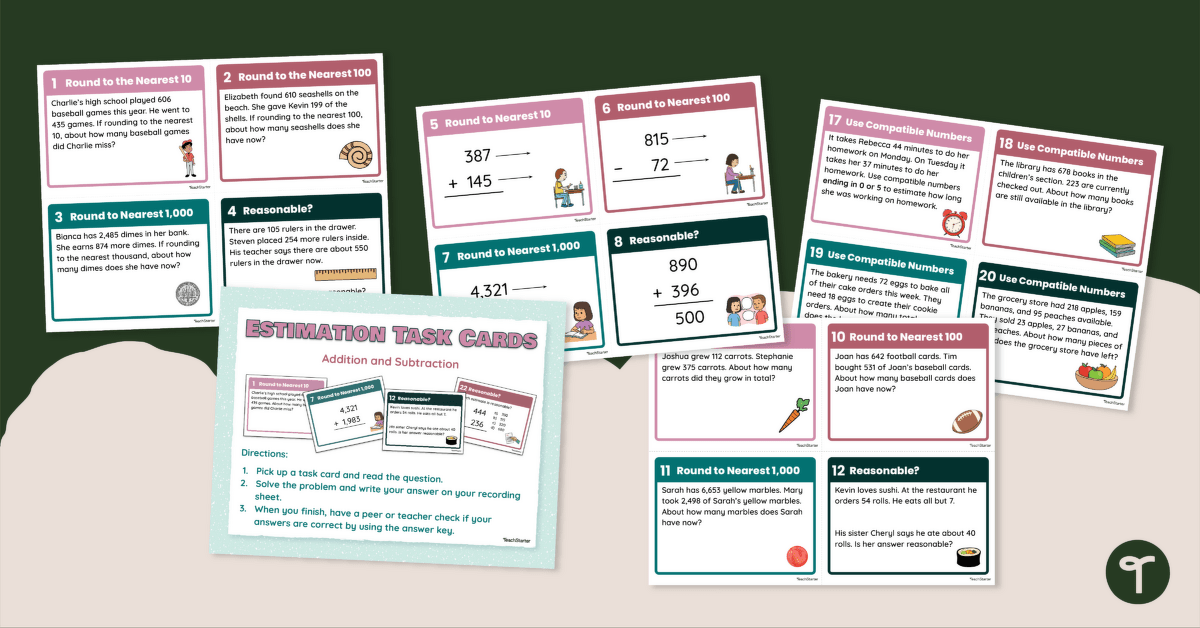Supercharge your students’ math skills with this set of task cards designed to help them master estimating sums and differences of whole numbers using rounding and compatible numbers.
Use Rounding and Compatible Numbers to Estimate
As you are teaching your students how to find the approximate answer to a problem, chances are, you’ve taught them how to round and use compatible numbers. If you are looking for a way to explain estimation to your students, read on for a quick primer from our teacher team!
Estimating in math means making a good guess about a number or a problem instead of finding the exact answer. Imagine you have a big pile of marbles and want to know how many are in there without counting each one. You can group some marbles together and think, “Hmm, there are about 50 marbles in this part and about 70 in that part, so there might be around 120 marbles in total.” That’s estimating!
To simplify guessing, it’s possible to use rounded numbers. For instance, if you have 48 and 73, rounding them to 50 and 70, respectively, can make the calculation easier. Adding 50 and 70 results in 120. Estimation is a useful technique to quickly obtain answers that are reasonably close to the actual one, especially when you don’t have paper and pencil handy.
Sometimes, rounding may give you a pretty close estimate, but compatible numbers may give an estimate that is even closer to the exact answer. A compatible number is essentially a friendly number (usually ending in 0 or 5) that makes a number easy to compute mentally. If we look at the above example, 48 + 73, this could change to 48 + 75 using compatible numbers, giving us a slightly closer approximation.
What Does Reasonable Mean in Math?
Along your student’s estimation journey, they will more than likely encounter questions where they have to determine the reasonableness of an answer. In order to solve questions such as these, they must put their estimation skills to the test!
When it comes to math, “reasonable” means that the answer or estimation you come up with makes sense within the given problem or calculation. This implies that the answer you get is likely to be correct based on your understanding of the problem and your math knowledge.
For instance, if you’re asked to estimate the cost of a meal at a restaurant and you give an estimation of $5, that would not be a reasonable estimate if you know that meals at that restaurant typically cost between $10 and $20. A more reasonable estimate in this scenario would fall within that price range, such as around $15.
In math, determining reasonableness often requires using common sense and your knowledge of numbers and operations to assess whether an answer is likely to be correct. This is a way to verify your work and ensure that your calculations align with your expectations based on the problem’s context.
Estimation Word Problems – 3rd Grade and 4th Grade Style!
Teach Starter has created a set of 24 task cards to help your students improve their understanding of rounding and compatible numbers to estimate. In this teacher-created resource, students will practice:
- Rounding to the nearest 10, 100, and 1,000 to solve word problems
- Standard practice problems with rounding and compatible numbers
- Determining if an answer is reasonable
- Compatible number word problems
This printable resource also includes a recording sheet for students to write their answers on and an answer key for quick and easy grading!
Download, Print and Prep!
If you are ready for your students to use their rounding and estimation skills, head over to the green download button! You can select from the quick-print PDF option or the editable Google Slides file. If choosing the Google Slides document, please note that you will first be prompted to make a copy of the resource to your personal drive before accessing it.
Consider printing the task cards on cardstock and laminating them to ensure they will last many years!
This resource was created by Kaylyn Chupp, a teacher in Florida and a Teach Starter Collaborator.
Extra Estimation Resources for Your Classroom!
Don’t stop there! We’ve got more estimation and rounding activities and resources that cut down on lesson planning time. Check out some of our suggested resources below!
[resource:5011008] [resource:5010237] [resource:5002336]












0 Comments
Write a review to help other teachers and parents like yourself. If you'd like to request a change to this resource, or report an error, select the corresponding tab above.